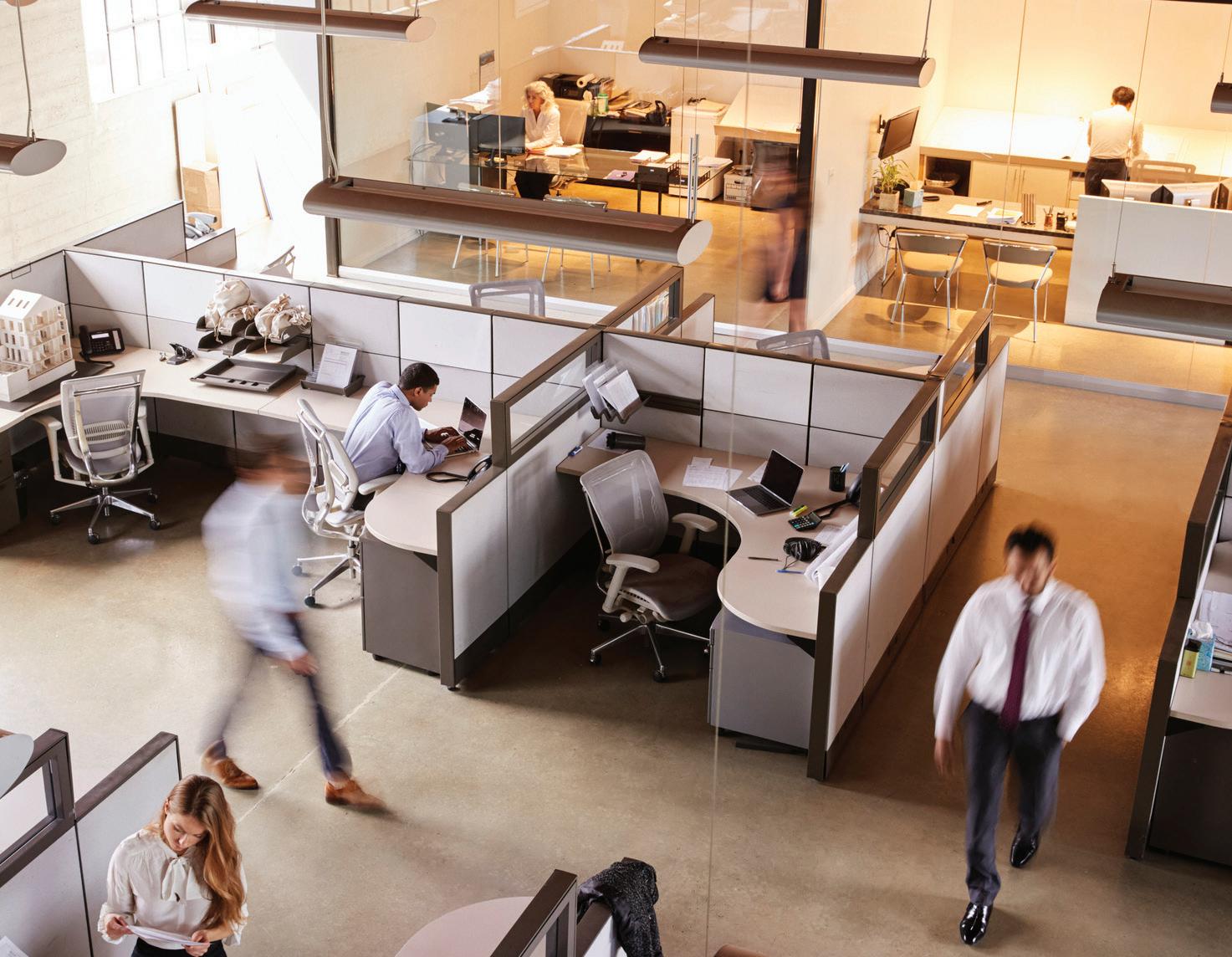
14 minute read
Building Industry Associations' Vital Role in Pandemic
Online Communications Replace Physical Meetings as Groups Cope with Crisis
5
California Buildings News • Q2 2020
Industry associations in normal times are useful networks for education, government relations and networking. In times of crisis, they are absolutely essential to the health of an industry—none more so than the companies that own, operate, design and construct buildings—and the companies that provide products and services to buildings. Beyond that, they are crucial to maintain vital business and social connections among people with interacting responsibilities. During this crisis, associations are proving very creative in serving their members.
That said, many industry chapters are under siege, because the programs and events they hold in normal times that generate sustaining revenue cannot be held. Some of their members face financial challenges and other resource constraints. It is absolutely critical that these groups are included in the many types of government programs aimed at providing relief, but even more important is the need for their members to continue to provide funding. They are an essential service.
“We’re using all of our resources and networks to construct a bridge over the pandemic’s river of chaos,” said Marc Intermaggio, executive vice president of BOMA San Francisco.
There are dozens of association chapters and groups around California that are providing valuable response efforts to deal with this once-in-acentury challenge to our economy and way of life.
For instance, the Building Owners
and Managers Association of San
Francisco went into action in early March and has continued adding services to its members as the crisis deepens. Executive Vice President Marc Intermaggio said in a recent member communication, “We’re using all of our resources and networks to construct a bridge over the pandemic’s river of chaos.”
His group began by providing timely information appropriate to the commercial real estate industry from government leaders, then opened pathways to all levels of government to provide industry input so government actions would be better focused. BOMA SF started a COVID19 resources page accessible through www.bomasf.org and made it a central resource for what its members need to respond to the crisis. Information provided concerns re-occupancy, transportation issues, tax and licensing deadlines, construction matters and a dedicated Slack channel so members can share experiences and sound off.
7
California Buildings News • Q2 2020

Buildings During—and After—the Pandemic Commercial Real Estate Will Undergo Dramatic Change

When Twitter in San Francisco announced in May that most of its nearly 5,000 employees could work from home indefinitely, it sent vibrations across the entire global spider web of commercial real estate. It was no aberration. In late April real estate trade group CoreNet Global reported after surveying its 11,000 members that “Corporate real estate professionals say that the use of remote work and virtual meetings will last beyond the immediate coronavirus (COVID-19) crisis, and a growing number say that the overall corporate footprint will likely shrink as a result.” Fully 94% said remote work will continue after the COVID19 pandemic and that virtual meetings will continue as a major form of collaboration. And 69% said their real estate portfolios will shrink. (See page 30 for more on CoreNet's report.)
Numerous factors drive this trend, far beyond corporate and organizational cost savings, which are typically only 2-3% of overall revenues for real estate. Concerns about working near others, the health and hassle of commuting to central business districts, the surprising increase in productivity from remote work in many cases and the sudden trend away from big downtowns will drive the future of work locations.
Even for companies that still focus most of their activities in traditional workplaces after the COVID-19 global trauma, workplace activity and design will never be the same again. But how will work be conducted, and what will workplaces and commercial and institutional real estate look like? Even using the most basic physical distancing, reopening offices envision blocks-long lines of workers waiting to get to use elevators restricted to only a few people at a time. It will take many hours to safely load a 40-story building in what was once a minutes-long process.
In what might resemble a science fiction movie, some companies are planning digital health screening methods before allowing people into workplaces or even buildings. Apps are being deployed to measure people’s physical distancing and contact tracing. Staggered work dates or times seem likely. Workers may be judged by health risks. Much more telework will be permanent—as will wholesale
(Continued on page 10)
Above: New and safer ways to office include redesigned workplaces with physical distancing safeguards and more employees working from home on either a full-or part-time basis.
8
California Buildings News

Able Services Advocates for Essential Cleaning Sector
Workers Play Vital Role in Keeping Buildings Operating During the Coronavirus Crisis
Industry leader Able Services recently joined said J. Paul Saccone, Chief Executive Officer of Able with six other organizations in the contract Services, a Coalition Board Member. cleaning sector to establish the Cleaning Coalition The contract cleaning service industry employs of America. The Coalition represents the needs of more than one million workers in every state in the an often-overlooked sector playing a vital role U.S., and it has been hard-hit by the economic impact keeping essential services of the coronavirus crisis. operating during the Accordingly, the Coalition coronavirus crisis.
As the country moves past this crisis to get back
Cleaners will be disinfecting workspaces, schools, airplanes, shopping centers, stadiums
is asking Congress and the Administration to support targeted to business, the contract and other public spaces to prepare them for measures that will help cleaning sector will again widespread use, reestablishing the public’s ensure the continuity of be on the front lines. Cleaners will be disinfecttrust in the systems that underpin society. business operations and the employment of ing workspaces, schools, its essential workforce. airplanes, shopping centers, “Since the pandemic stadiums and other public began, Able has been on spaces to prepare them for widespread use, reestablishing the forefront of practicing safe cleaning practices and the public’s trust in the systems that underpin society. working with BOMA San Francisco principal members to
“Health and safety is the number one priority for our service their buildings and establish new protocols,” says employees, clients and communities. We’re looking to Able President Mark Kelly. “Our company is thankful to preserve jobs and maintain access to much-needed the many janitors, engineers and maintenance workers personal protective equipment for our workers, so that for their dedication in stepping up and keeping buildings they can continue to do their jobs which are an essential clean and safe. We’ve always known that these workers part of getting the American economy moving again,” were essential. Now the world does, too.”
To learn more about Able:
www.ableserve.com u 800.461.9033 Mark Kelly at mkelly@ableserve.com
For information about the Cleaning Coalition of America:
www.CleaningCoalition.org
the ART of Building Sustainability
TECHNOLOGY THAT SUPPORTS REAL-TIME FDD USING EXISTING NETWORK ARCHITECTURES.
Does your IoT vendor offer real-time fault detection and diagnostics without third-party involvement?
In addition to a high level of integration between HVAC, lighting, and security systems, sustainability demands other technological and supporting elements that will endure over the long term. At Reliable Controls, we provide nine important elements to help you create true building sustainability—now and into the future. One of these elements demands the use of technology that integrates real-time fault detection and diagnostics into existing network infrastructure. Reliable Controls integrates real-time fault detection and diagnostics capabilities into our products, saving you the time and money involved in implementing third-party reporting. Using existing infrastructure, our live fault-reporting technology empowers building operators to diagnose and resolve issues as they happen—so your facilities run smoothly and efficiently.


To learn more about the art of building sustainability please visit reliablecontrols.com/TABS6C20
10
California Buildings News • Q2 2020
CRE & Pandemic (Continued from page 7) workplace redesigns. Getting back to work will challenge all our creativity and patience. We canvassed leading designers, futurists, product makers and economic analysts.
See box at right for some overall conclusions and emerging trends.
California Governor Gavin Newsom made it clear in April that when the time comes to more fully reopen businesses and schools “we will have to redesign them” to accommodate physical distancing for the foreseeable future with greater spaces between workers and students. He noted that would likely mean “staggering” work and school hours. Additionally, he said workplaces, parks and other public spaces will be subjected to regular “massive deep cleaning.”
Los Angeles-based commercial real estate futurist Christopher Lee says in his influential Strategic Advantage report, “Where and how we work, where and how we shop, where and how we live and where and how we spend our leisure time is forever changed. COVID19 sparked a debate over human rights, property rights, privacy rights, societal rights and government rights. The pace, impact and lasting changes will reverberate within every market and every asset class. Ironically, or perhaps just great timing, the real estate cycle, which peaked in 2019, was already faced with a tsunami of transformative events occurring simultaneously…the Coronavirus just accelerated many gradual changes into light speed transformations.
“From PropTech to consolidation, from legacy exits to the emergence of new competitors, from business as usual to business with a purpose and from Big Data to AI and AR, the real estate industry in 2020, as a result of COVID-19, will change. What once was is no longer a certainty. What we could rely upon is no longer reliable. What we could ‘count on,’ is now a memory. We are in unchartered waters. The time to change is now… tomorrow is too late. Your ability to shape your future should be your #1 priority. You can’t change yesterday, but you can seize the moment and create the future you want it to be.” For more extensive analysis from Lee, visit: http://www.celassociates.com/
Pandemic-Induced Massive Trends
n Workplaces will house fewer people, as much more remote work will be a norm, but office space that is needed could remain the same because square footage per worker will be increased to provide healthier distances between people and staggered work hours. n In many cases, telework will also prove to be much productive and desirable, resulting in a new definition of workplaces and much more flexibility as to when and where employees gather—via ZOOM-type technology or satellite offices in the suburbs. According to the Brookings Institution, nearly half of all employed Americans are working from home during this pandemic. Other reports say most want to work at least some if not all of the time from home in the future. n A vast array of new products and services will be needed to reimagine workplaces, from touchless appliances to cleaner bathrooms to elevator innovations to artificial intelligence, greater sensoring, tenant improvement design and solutions to permit employees to work better from home. n Workplace and multifamily living spaces will become much healthier as they are retrofitted for greater space between workers and retooled with a host of products and devices designed to test for illness and improve hygiene, such as touchless products and more robust HVACR to improve indoor health. n Technologies of all types that facilitate working remotely, using robots, artificial intelligence, sensoring, space planning and new forms of communications will become widespread. n Greater emphasis on the value of workers’ wellness and productivity versus real estate costs per worker. n Buildings sectors could morph dramatically, with much less retail space and many more logistics facilities (warehouses, transit hubs, etc.) as shopping continues its rapid acceleration from malls and stores to online shopping and delivery. n Massive retraining will occur as people move from weak to strong economic sectors for employment. Education to facilitate new and different employment will move from highly costly 19th century brick-and-mortar colleges and universities to much more affordable, less bureaucratic and immediately relevant online coursework and career certifications. n The entire travel industry will shrink (hotels, air travel and cruise lines) and be remade as fear reduces unnecessary trips and excursions, resulting in many facilities being reconceived for housing, medical or short-distance, drive-to destinations. n The healthcare sector will boom as focus on the need for hospitals, labs, training and other medical facilities grows dramatically, with much more government and private-sector funding flowing to these operations.
11
California Buildings News • Q2 2020
How Some Architects View Future Workplace
A joint statement from Daniel Herriott, HOK director of design in San Francisco, and Kay Sargent, HOK’s global director of workplace, said “COVID-19 will have many lasting impacts on how and where we work, not the least of which will be a heightened sensitivity regarding density and proximity to others within the workplace. Companies will likely be less focused on densification and be more focused on ways to allow physical distancing in the workplace. The drive to reduce square feet per person will likely be replaced with using what you have more wisely to enable people to feel safe.
“In work spaces that are currently under-utilized, enabling that spacing can more easily be accomplished. But for companies with a higher density and Photo: Adobe Stock.


utilization, they will need to assess ways to enable appropriate spacing between people. That might be a combination of modifying existing space layouts, providing some form of shielding and embracing remote work as part of the strategy. Many view the opportunity to increase distributed working as a potential for reducing their overall space needs. But even if companies are leveraging remote work, they may find their overall square feet per work point increasing to enable distancing, hence the amount of space they could release is not proportional.
“The reality is having people work remotely one or two days a week doesn’t really deliver space or cost savings, because it doesn’t necessarily reduce the number of work points needed in an environment with assigned work points. When staff starts to work remotely three days a week, and/or they opt for Activity-Based Working (ABW) with unassigned desking, then the opportunity to reduce space and cost can be realized. Empowering people with the option to be mobile, be it within the work place or from a remote location, not only allows them to pick the right setting for the task at hand, it also allows them to choose their neighbors, and how close to (Continued on page 26)
12
California Buildings News • Q2 2020
XL2 Acoustic Analyzer High performance and cost efficient hand held Analyzer for Community Noise Monitoring, Building Acoustics and Industrial Noise Control
An unmatched set of analysis functions is already available in the base package:
• Sound Level Meter (SLM) with simultaneous, instantaneous and averaged measurements • 1/1 or 1/3 octave RTA with individual LEQ, timer control & logging • Reverb time measurement RT-60 • Real time high-resolution FFT • Reporting, data logging, WAV and voice note recording • User profiles for customized or simplified use
Extended Acoustics Package (option) provides:
• Percentiles for wideband or spectral values • High resolution, uncompressed 24 Bit / 48 kHz wave file recording • Limit monitoring and external I/O control • Event handling (level and ext. input trigger)
Spectral limits (option) provides:
• 1/6 th and 1/12 th octave analysis
Sound Level Meter (SLM)

Real Time Analyzer (RTA)
Noise Curves Spectral Limits 1/12 th (SLO)
For more information visit:
www.nti-audio.com
i-ince half page landscape PTB.indd 1
NTI Audio AG
9494 Schaan Liechtenstein +423 239 6060
NTI Americas Inc.
Tigard / Oregon 97281 USA +1 503 684 7050
NTI China
215000 Suzhou China +86 512 6802 0075
NTI Japan
130-0026 Sumida-ku, Tokyo Japan +81 3 3634 6110 Made in Switzerland
05.03.2019 15:45:30
Acoustical Door and Window Wall Unit
Highest Acoustical Rating—up to STC 52
Krieger’s Acoustical Door and Window Wall Unit underwent rigorous lab testing—in multiple configurations, testing higher than any other wall unit on the market.
Customizable Configuration
Configured to your exact specifications of size, number and placement of doors and windows. Plus, the construction makes it possible to swap out the doors, panels, transoms, and side lights in case your needs change.

Fire Rated
Fire rated up to 90 minutes with glazing or up to 3 hours with acoustical transom of side light panels.
All Krieger’s products are designed and manufactured in California.





